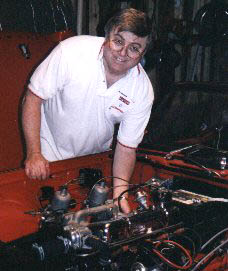|
1962 Triumph TR4 Restoration |
|
Brian Sanborn, Groton, MA |
Starting The Engine

Cross your Fingers and Fire It Up
I was a little bit on the terrified side on this part. I had all kinds of second thoughts. Did I remember to do this? Should I have done this or that an other way? Would the whole thing just grind to a smoky halt. But it was exciting.
The first thing, I believe, is to take a break after putting everything together. Out of business necessity, I waited a whole week. Approach the re-installed engine and engine bay accessories from a fresh viewpoint and double check everything for completeness, correct wiring and proper operation. Make sure there is oil in the engine and up to the right level. Use a ordinary grade of 10W30 for the break in. We will change this out after 200 miles. Check the oil filter and oil pressure lines for proper fit and tightness. Is there water/antifreeze in the radiator and check the spigots on the right hand side of the block and the bottom of the radiator.
The next task is to insure good lubrication during the initial starting phase. Even though you have buttered up every moving part with assembly lube during the engine assembly... the first 30 seconds of engine operation are critical. We want to force oil into the dry galleries, filter and up into the head. Take out the spark plugs, put the gearbox in neutral and crank the engine until you see the oil pressure appear on the dash gauge. The engine will crank pretty fast with no compression load. Be sure to crank the engine in short duty cycles to keep from overheating the starter. Crank for 10-15 seconds and rest for 45 seconds. After a few cycles the gauge needle will suddenly rise up to confirm that the internal oil passages are primed.
If you can't get any pressure, go back and check the obvious stuff. But you may have to pull the pan, open the oil pump and pack it with assembly lube. This should have been done during assembly. Some folks have described a trick using a cut off screw driver blade chucked into a power drill to drive the oil pump shaft from under the removed distributor and distributor drive gear. Don't damage the bronze distributor drive bushing. This can splash a lot of oil up the shaft if successful... so keep you head up. And others have crossed their figures and started the engine... planning to shut it off if they don't see oil pressure in 20 seconds or so. I would not go this route.
Now we can re-install the spark plugs, give the starter a rest for a while and bring the rebuilt engine to life once more. You will need a helper on hand to look for troubles or leaks while you work the ignition key. Give it appropriate choke for the temperature and crank away. If all is well...The engine should fire quickly. For the first 20 minutes keep the revs up around 2000 RPM. Don't let it idle for long periods during the beginning phase. This is when the first bedding down occurs and lubrication of the camshaft and lifters is critical.
Follow new car break-in instructions for the operation of the engine. After 200 miles or so, flush out the engine by changing the oil to the regular recommended premium quality oil... 15W40 or whatever you use... and installing a new premium small micron filter. That way any bits of metal or dirt that have accumulated are out of the way. Don't use synthetic yet. I happen prefer synthetic... but the conventional wisdom is that it is too slippery for break-in use and will slow the process. I kept regular type oil in the engine for the first 1500 miles.
If the car is driveable.... take it for ride and listen to it purr!!